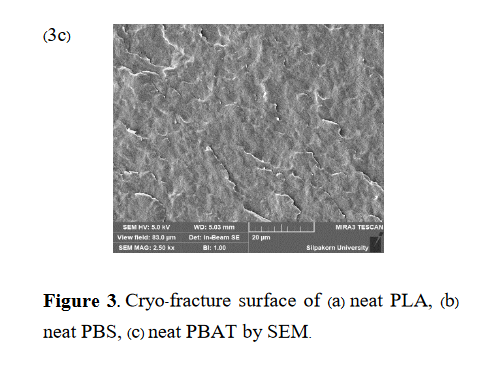Properties of Ternary Blends of Compostable PLA/PBAT/PBS
DOI:
https://doi.org/10.53848/ssstj.v9i2.228Keywords:
Circularity, Ternary blend, Compostable plasticAbstract
Compostable plastics such as Poly (lactic acid) (PLA), Poly(butylene succinate) (PBS) and Poly(butylene adipate-coterephthalate) (PBAT) have been extensively used in many applications, from commodity to engineering ones. These plastics offer the circularity of the carbon cycle. However, each of them has advantages and disadvantages. The ternary blend of these three are therefore very interesting in terms of phase morphology and their physical properties while offering compostable practices. In this work, the blends of PLA/PBAT/PBS were studied. PLA/PBAT was fixed at 50/50 whereas PBS was varied from 10 to 40 % wt. In order to ensure the compatibility, peroxide and carbodiimide compounds were used. The results show an immiscibility of PLA/PBAT/PBS blend, with continuous surface of PLA and PBAT while PBS is dispersed phase. However, it shows the better interfacial adhesion of PLA/PBAT/PBS when reactive compounds were added. The mechanical properties indicated the modulus of all blends higher than neat PBAT (~52 MPa) and PBS (~377 MPa). However, it insignificantly changed when increased PBS contents, similar to the tensile strength results.
References
Chaiwutthinan, P., Chuayjuljit, S., Srasomsub, S., & Boonmahitthisud, A. ( 2019) . Composites of Poly (lactic acid) / poly( butylene adipate‐co‐terephthalate) blend with wood fiber and wollastonite: Physical properties, morphology, and biodegradability. Journal of Applied Polymer Science, 136. doi:10.1002/app.47543
Cherykhunthod, W., Seadan, M., & Suttiruengwong, S. (2015). Effect of peroxide and chain extender on mechanical properties and morphology of poly (butylene succinate)/poly (lactic acid) blends. IOP Conference Series: Materials Science and Engineering, 87, 012073. doi:10.1088/1757-899x/87/1/012073
Ellen MacArthur Foundation. (2020). Circular economy. Retrieved from http://www.ellenmacarthurfoundation.org
Hongdilokkul, P., Keeratipinit, K., Chawthai, S., Hararak, B., Seadan, M., & Suttiruengwong, S. (2015) . A study on properties of PLA/PBAT from blown film process. IOP Conference Series: Materials Science and Engineering, 87, 012112. doi:10.1088/1757-899x/87/1/ 012112
Pitivut, S., Suttiruengwong, S., & Seadan, M. (2015). Effect of reactive agent and transesterification catalyst on properties of PLA/PBAT blends. IOP Conference Series: Materials Science and Engineering, 87, 012090. doi:10.1088/1757-899X/87/ 1/012090
Prasong, W., Ishigami, A., Thumsorn, S., Kurose, T., & Ito, H. (2021). Improvement of interlayer adhesion and heat resistance of biodegradable ternary blend composite 3D printing. Polymers, 13(5), 740. doi:10.3390/polym13050740
Ravati, S., Beaulieu, C., Zolali, A. M., & Favis, B. D. (2014). High performance materials based on a self-assembled multiple-percolated ternary blend. AIChE Journal, 60, 3005-3012. doi:10.1002/aic.14495
Ravati, S., & Favis, B. D. (2013). Tunable morphologies for ternary blends with poly (butylene succinate): Partial and complete wetting phenomena. Polymer, 54(13), 3271-3281. doi:https://doi.org/10.1016/j.polymer.2013.04.005
Wu, D., Huang, A., Fan, J., Xu, R., Liu, P., Li, G., & Yang, S. (2020). Effect of blending procedures and reactive compatibilizers on the properties of biodegradable poly(butylene adipate-coterephthalate)/poly(lactic acid) blends. Journal of Polymer Engineering, 41. doi:10.1515/polyeng-2020-0161
Wu, F., Misra, M., & Mohanty, A. K. (2019). Super toughened poly (lactic acid)-based ternary blends via enhancing interfacial compatibility. ACS Omega, 4, 1955-1968. doi:10.1021/acsomega.8b02587
Wu, F., Misra, M., & Mohanty, A. K. (2020). Tailoring the toughness of sustainable polymer blends from biodegradable plastics via morphology transition observed by atomic force microscopy. Polymer Degradation and Stability, 173, 109066. doi:10.1016/j.polymdegradstab.2019.109066













